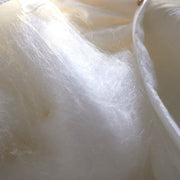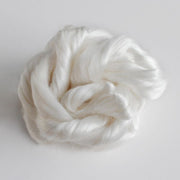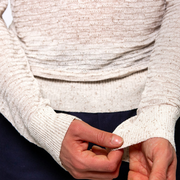How silk is born
Silk is a natural protein fiber obtained from the cocoon of the silkworm ( Bombyx mori ).
A single cocoon can contain up to 1,500 meters of continuous thread , very thin but strong.
Spinning takes place through a delicate process:
Each phase is carried out with extreme care, to preserve the shine, continuity and softness of the fibre.
Technical characteristics of silk
Behind its luxurious appearance, silk hides a series of extraordinary technical properties:
-
Thermoregulating
It insulates from the heat and protects from the cold.
-
Highly breathable
It lets air pass through, keeping your skin cool.
-
Soft and fluid
It adapts to the body's movements with ease.
-
Hypoallergenic
Also suitable for sensitive skin.
-
Resistant
Despite being thin, it has excellent mechanical strength.
Furthermore, silk has a natural, never artificial shine: it reflects light in a discreet way, creating unique visual effects depending on the weave.
Silk in knitwear: a contemporary challenge
Traditionally associated with weaving (shirts, ties, scarves), today silk is also entering the world of sophisticated knitwear , thanks to advanced spinning technologies and sophisticated blends.
Knitting silk requires calibrated machines, experience and precision, as the fibre has minimal elasticity and twist , and tends to “slip” during processing.
For this reason, it is often mixed with plant fibers such as linen, which give it structure, body and hold.
The future also passes through silk
Sustainable by nature, precious by history, high-performance by construction: silk represents a meeting point between past and future .
Using it today in a modern way, in knitwear, in intelligent blends and
versatile, it is a choice of aesthetics, but also of responsibility .
In an essential wardrobe, a silk (or linen and silk) garment is not a whim: it is a foundation of comfort and refinement.
A fixed point for those who don't follow trends, but recognize quality.


